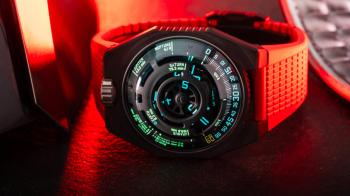These include the number 299,792,458 km/s. It's a mysterious figure relating as much to the physical theory of classical mechanics as it does with Azimov’s worlds of fantasy. It represents the ultimate speed: that of the propagation of energy, mastered only by the initiated. A pervasive constant, the speed of light symbolised by the letter "c".
This almost mystical number calls to mind both the foundations of Einstein's theory of relativity and the futuristic visions of a distant galaxy explored by the Jedi of Star Wars and the intrepid captains of Star Trek. Mastering this speed means plunging into hyperspace, defying the laws of physics and navigating through the universe’s multiple dimensions. An adventure worthy of the greatest explorers, from the Goa'uld tacticians in Stargate to the Spacing Guild navigators in Dune.

URWERK's UR-100V LightSpeed is the realisation of this dream, bringing Time, Space and Light together in a single place. URWERK’s artistic director and co-founder Martin Frei says: "Wearing this creation is like having a piece of the universe on your wrist, a vision of the cosmos in miniature, on a human scale.” The UR-100V LightSpeed houses a 3D planetarium featuring eight celestial bodies from our solar system, eight points of reference. "Starting from the Sun, we calculated and illustrated the time taken for a ray of light to reach each of the planets. The Sun’s rays take 8.3 minutes to reach the Earth, while the same ray reaches the surface of Jupiter 35 minutes later. A journey through space and time with light as the medium, the most magical of all vessels” he explains. "This is the story we were all told as children”, adds URWERK’s master watchmaker and co-founder Felix Baumgartner. “It is the one that explains our place on Earth, the immensity of the universe and our out-of-step relationship with the present moment: by the time the light of a star reaches us, that star has probably long since ceased to shine. What we see is no longer there; we perceive a time, a past that no longer exists.”
It's a fact. The Sun’s rays reach every planet in a specific measured time, reminding us of the dizzying distance and ephemeral beauty of our solar system. The light we see today is an echo of the past, an instant frozen in cosmic time. Within our space-time system, the Sun's light reaches Mercury in 3.2 minutes, Venus in 6 minutes, Earth in 8.3 minutes, Mars in 12.6 minutes, Jupiter in 43.2 minutes, Saturn in 79.3 minutes, Uranus in 159.6 minutes and Neptune in 4.1 hours. Such is the beauty embodied by the UR-100V LightSpeed, whose ultimate reference is the Sun, which inspires the rotor on the back of the timepiece.

“Light serves as our connection to the Universe, representing the smallest unit of energy capable of being transmitted. Its electromagnetic radiations are precisely in the range that our eyes are attuned to detect. This ability to visualise and interpret this information reconstructs our perception of the world. Whether gazing at distant stars or peering though a microscope, light conveys essential details shaping our understanding of reality, continually expanding our knowledge and comprehension of the vast and intricate universe around us.” concludes Martin Frei.
In addition to its interstellar dimension, the UR-100V LightSpeed pick up the principle of displaying the hours and minutes, which is based on the absence of hands. Instead, a satellite moves along an arc of a graduated circle. The first carries the hours, the second the minutes. And when an hour satellite has covered its 60 minutes, the next one bearing the next hou, appears in front of the minutes index. No one could have imagined that this principle – extrapolated from a 17th century clock – could be so creatively thought out, transformed and transmuted in space, volume and time.







